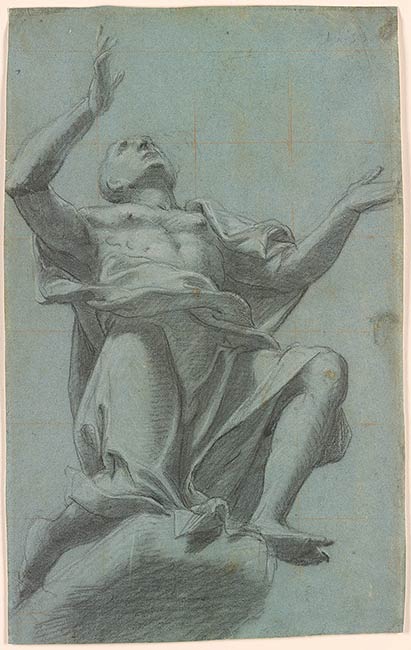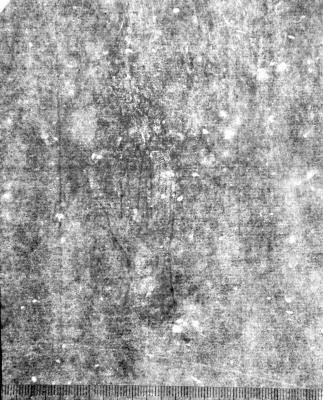
Drawn on a fine sheet of blue paper, this figure seen di sotto in su is one of the preparatory studies—all similar in style and technique—for the Apostles depicted by Urbino in the dome of the Speciano (now Bombardieri) chapel in the church of San Marco in Milan.1 The figure depicted in the Morgan’s sheet, kneeling on a plinth with his arms spread and looking upward, corresponds almost perfectly in reverse to the Apostle wearing a silvery-white tunic in the fresco.
Monsignor Cesare Speciano (1539– 1607) was responsible for the decoration of the church at the end of the 1570s. It included, on the side walls, frescoes by Bernardino Campi that were destroyed around 1610. Although Alessandro Lamo correctly credits the Speciano chapel’s dome frescoes to Urbino in his Discorso intorno alla scoltura e pittura . . . ,2 these paintings were later attributed to the Milanese painter and art theorist Giovanni Paolo Lomazzo, who was completing the decoration of the dome of the Foppa chapel in San Marco during the same period.3 The Foppa chapel was adorned with prophets and sybils seen di sotto in su, closely resembling Urbino’s figures in the dome of the Speciano chapel.
Because the exact date of Urbino’s frescoes is not known, it would be imprudent to attempt to establish whether it was Urbino who influenced Lomazzo or the reverse. Both Urbino and Lomazzo, however, were in those years intensely engaged with the problem of rendering perspective in painting, carrying on a long cultural debate that had interested Lombard artists since the end of the quattrocento. Lomazzo, for example, dedicated an entire section of his Trattato dell’arte della pittura, scoltura et architettura (1585) to the problem of prospettiva. He explained that perspective was a quintessential component of the Lombard school: “This discipline [perspective] is typical of the Lombard painters, as drawing is for the Romans, color for the Venetians, and strange inventions for the Germans.”4
Urbino was considered in Milan a specialist in the study of perspective. The Venetian biographer Carlo Ridolfi recorded that the artist was “learned in symmetry and perspective and skilled in arranging figures in their relations by means of the vanishing point.”5 Along with the local Lombard tradition, Urbino (who first trained in the Veneto) was probably also aware of the curvilinear perspective of Tintoretto and the views di sotto in su in Paolo Veronese’s works. Urbino is also today unanimously considered the author of the famous Codex Huygens, also at the Morgan (see 2006.14:1-128). Compiled for the use of painters, the codex was composed around 1569, shortly before the completion of the frescoes in the Speciano chapel. In the fifth section of the codex, Urbino discusses the perspectival representation of the figure, accompanying the text with drawings depicting models seen di sotto in su. Some of these closely recall the Apostles in the Speciano chapel, which seem to have been conceived as a visual trans- position of the art theories illustrated in the codex (see 2006.14:111).
Arranged in a circle along the perimeter of the dome of the chapel, the twenty-six standing male figures are depicted in a striking variety of poses. Each figure must have been studied by Urbino on large blue paper sheets like the present drawing, although fewer than ten preparatory drawings for the project survive. A small, now dismembered, volume, originally containing about 133 drawings, included a group of 34 copies after Urbino’s figure studies for the Speciano chapel.6 One of the pages, erroneously considered by Giovanni Cirillo to be an autograph work of Urbino, shows an exact copy of the Morgan drawing. The mediocre quality of the drawing contained in the volume, however, and its pedantic execution, would suggest that the sheet—together with the others in the volume—was most certainly produced by a member of Urbino’s workshop as a model book meant either for training purposes or to record the figures for future compositions.
—MSB
Footnotes:
- Other preparatory drawings for the figures in the dome are in the Biblioteca Ambrosiana,
- Milan (see Bora 1971, 42–47, nos. 50–61, who initially attributed the drawings to Giovanni Paolo Lomazzo); Palazzo Rosso, Genoa, inv. 1560, 1558, and 1559 (see Gavazza 1974, as Andrea Ansaldo); Christ Church Picture Gallery, Oxford, inv. 1081 (formerly as Lomazzo); and where- abouts unknown (see New York 1999a, no. 2).
- Lamo 1584, 94–95.
- On the Foppa chapel, see Marciari 2012.
- “È propria [dei pittori lombardi] questa parte [la prospettiva] si’ come il disegno è peculiare de’ romani, il colorire dei veneziani e le bizarre invenzioni de’ germani.” See Lomazzo 1973–75, 2:275.
- “Studioso della simmetria e delle prospettive e accurato nel collocare le figure ne’ siti loro con le osservationi del punto.” Ridolfi 1914–24, 1:413.
- Cirillo 2005, 117 and ff., and fig. 43.
Watermark: Hand with open thumb, surmounted by a flower (similar to Briquet 10722: Rome 1543).
Rhoda Eitel-Porter and and John Marciari, Italian Renaissance Drawings at the Morgan Library & Museum, New York, 2019, no. 54.
Selected references: Di Giampaolo and Turner 1978, 76 (as Giovanni Paolo Lomazzo); Bora 1979, 102-4; Bora 1980a, 317, no. 59; Cirillo 2005, 166, no. 224.
Giulio Bora, "Un ciclo di affreschi, due artisti e una bottega a S. Maria di Campagna a Pallanza," Arte Lombarda 52, 1979, p. 104, fig. 32.

